Snug Blog
At Snug Pet Resort, our decades of experience in handling aggressive dogs have taught us valuable insights into effective training and management. In this blog post, we share essential tips and strategies for owners dealing with canine aggression.
At Snug Pet Resort, we have extensive experience handling aggressive dogs and assisting owners with aggression issues. I began training dogs in the early ’90s, participating in protection sports, and working with various police and military dogs. This diverse background provided me with extensive knowledge on dealing with dogs exhibiting aggression. In protection training, we focus on teaching dogs when to be protective, how to be protective, and, most importantly, when to stop on command immediately.
With over 30 years of experience in competing and training, I’ve gained a significant advantage in working with dogs facing aggression problems. The techniques we employ today are a combination of what I’ve learned and developed from protection training. It’s important to note that it’s impossible to cure an aggressive dog; our goal is to manage the dog and educate the handler/owner. Through proper client education, we aim to prevent accidents and allow dogs to remain in their families without further incidents.
While no owner is perfect, their active participation in the game plan can lead to success. We teach owners to understand their dog’s capabilities, appropriate scenarios, and the importance of avoiding uncontrolled environments. For instance, we strongly advise against taking a dog-aggressive dog to a dog park or beach, as it poses risks in unfamiliar settings with unknown dog behaviors.
Our training programs focus on helping owners identify triggers, anticipate them, and prevent dogs from reaching the red zone. In-person training with our experienced trainers is an integral part of all our programs.
If you’re an owner dealing with an aggressive dog, I encourage you to be open-minded. Some clients stick to specific training methods they find online, but it’s crucial to choose methods tailored to truly aggressive dogs. When seeking a trainer, prioritize experience in teaching, controlling, and understanding aggression. I’ve encountered many owners who regretted not doing so and felt they wasted their money on ineffective training.
On a related note, understanding dog body language is crucial. A wagging tail generally signifies a happy dog, but a tucked or rigid tail can indicate discomfort, alarm, or a feeling of threat. When meeting a dog, especially one with aggression issues, be cautious if the ears are up and the tail isn’t wagging – it’s a sign to approach with care.
If you’re navigating the challenges of an aggressive dog, take the first step towards a safer and happier life for both you and your furry friend. Explore our comprehensive training programs and learn from our experienced trainers who specialize in understanding and controlling aggression. Your dog’s well-being is our priority—click here to start your journey to a harmonious relationship today.
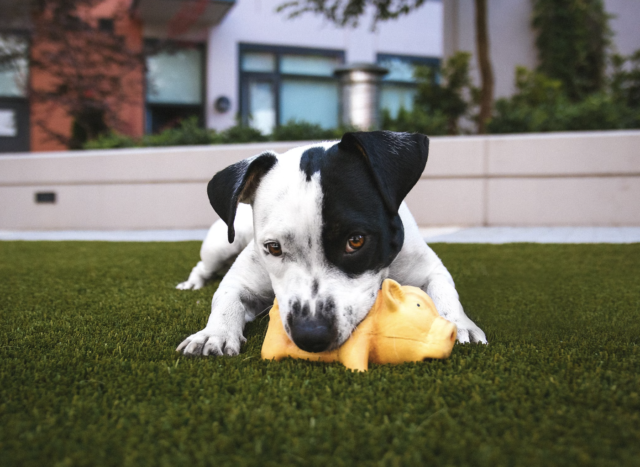
Peanut-detecting mutt Layla sniffs out danger, helps boy fight peanut allergy
BY Amy Sacks
SPECIAL TO THE NEWS: NYDailyNews.com
Saturday, November 6th 2010, 4:00 AM
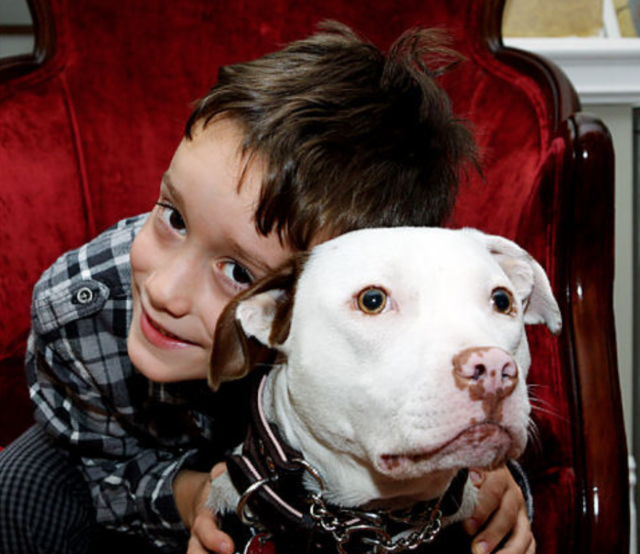
Grey Sheer, who’s allergic to peanuts, snuggles up to Layla, the family’s pit bull mix that’s been trained to detect their scent.
As a service dog in training, Layla searches her family’s grocery bags, kitchen cabinets, backpacks, stairwells, playgrounds, hotel rooms and other suspicious areas for the odor she was trained to detect: peanuts.
When the young pit bull/bulldog mix detects even the tiniest scent of a peanut, she lies down on her belly, stares at the culprit and points with her paw. Her reward: a squeaky ball.
This subtle act of heroism is a lifesaver for her Manhattan owners and their 6-year-old son, Grey, whose severe allergic reactions to peanuts and shellfish have landed him in the hospital at least a dozen times.
The boy’s food allergy first reared its head when, at age 2, Grey went into anaphylactic shock after eating a peanut butter cracker that had rolled under the couch.
“We’re constantly afraid that he’s going to die,” said his mom, Catherine Sheer, 28, who noted that Grey’s allergy is so bad he can break out in hives just walking down the aisle at the Whole Foods market. “It’s like living in a world where there’s cyanide everywhere,” she added.
Peanuts – or their scent – are all around us. Their residue, which can be in the form of butter, oil or dust, is found or left behind in schoolyards, libraries, movie theaters, on airplane seats and just about anywhere people go.
For that reason, many kids with peanut allergies are home-schooled and rarely have play dates.
“I was determined for him to have a normal life,” said Sheer, who is dismayed that service dogs are not allowed in New York City‘s public schools.
Still, Grey attends public school in Chinatown – unlike his preschool, it is not peanut-free – where he is shadowed by a paraprofessional who makes sure the boy steers clear of any nuts. Grey’s family and the school nurse are armed with epinephrine and Benadryl to treat allergic reactions.
Meanwhile, Layla, a rescued pooch, was never meant to be a peanut-detector dog. Grey and his mom were on their way home from school one day when they spotted the 4-month-old puppy playing in the window of the Animal Haven Shelter in SoHo. Layla had been flown in from an overrun Missouri shelter by Paws and Pilots as part of a big rescue effort.
It was love at first sight for Sheer when Layla licked her hand and then rolled over and went to sleep.
“She’s gentle and calm and the best dog in the universe,” Sheer said of the mixed breed with a bad reputation, who, despite urban myth, is even tender with her year-old baby, Scarlett.
The idea to train Layla as a scent detection dog occurred to Sheer in August during a month-long family trip to San Diego, but she was told that scent dogs are generally shepherds, poodles and golden and Labrador retrievers.
When the family took a day trip to Legoland, however, Layla stayed at the Snug Pet Resort, where trainer Mike Stone saw great promise in the loyal mutt as a “peanut dog” and agreed to try training her, Sheer said.
After spending two months out West with Stone, Layla recently returned to Manhattan, where, despite her young age and breed, she continues to show great promise as a lifesaver for Grey.
While pit bulls aren’t generally used as scent dogs, Sheer believes their great desire to please their owners make them worthy of the job.Read more: http://www.nydailynews.com/lifestyle/pets/2010/11/06/2010-11-06_sniffing_out_danger_peanutdetecting_mutt_helps_boy_fight_allergy.html#ixzz16hLGdr9w
I get asked all the time about when it’s best to start training your puppy. The correct answer is: the day you get your puppy.
Starting a puppy out in the right direction is such a huge advantage for the puppy and the owner. Think about never letting your puppy develop any bad habits. There are some many things we can do with a puppy.
What You Should Do
- House manners/housebreaking: Using a crate will help your puppy begin to learn to hold its bowels and bladder and to indicate to you when the puppy needs to go outside to potty. Without a plan, your puppy will learn to go potty anywhere in the house and you’ll be left trying to fix a bad habit.
- Socializing with new people and surroundings: Puppies have a small window of opportunity to adapt to new surroundings and meeting new people. If we don’t get the puppy social, we could have a puppy who is not receptive to new things and new people. This can lead to many behavior problems that are very, very difficult to try to undo! Take your puppy to fun, positive places for short introductions to new surroundings and new people. Remember not to introduce your puppy to other dogs or take your puppy to places heavily populated with dogs. Your puppy is not yet fully vaccinated from the communicable diseases other dogs might have.
- Obedience work — teaching your dog to follow your cues: I make all learning positive-based fun for the puppy! Try short lessons where your pup will earn rewards for following your cues. Keep it to no longer than 2-3 minutes, as the puppy cannot concentrate longer than that. Too long of a session and your puppy gets fatigued and associates training with an unpleasant experience and you can become frustrated. Keep it short and fun!
- Imprinting good habits and curbing bad ones: Every little thing your puppy does at an early age is an exploration of new things and potential habits. Think about the first time your puppy starts to chew on the table leg. The puppy is teething and this is providing comfort and fun for the puppy. If not corrected by the pack leader, the puppy will associate a positive experience with chewing the table leg. So keep a close eye on the pup and discourage unwanted behaviors, followed by encouraging good behaviors. In the table-chewing situation, try offering an acceptable puppy chew toy to impart what is OK and what is not OK to chew on!
Need Help?
Start right away with a game plan to set up your dog and family for decades of good behavior. Or, better yet, contact Snug Pet Resort today to learn how we at Snug can use our experience to get your puppy off to a great start.
Mike Stone
October Special: 10% off boot camp!
Take advantage of this once-a-year special before spots fill up! The trainers at Snug Pet Resort are experts in canine behavior, and dog training is their full-time job. We’ve been training dogs professionally for 25 years, and our effectiveness is why we are the most-trusted trainers in San Diego. Call us today to find out which of our may options is best for you, your pet and your budget.
Think about it:
- Eliminating a potty training or house-breaking problem takes just a phone call.
- Trouble with destructive or aggressive behavior ? No problem. We can fix it.
- Before long, you can have complete control of your dog — without a leash.
Take advantage of this offer to improve your pet’s behavior for years to come. We offer a range of options, including packages of four, eight or 12 lessons and various boot camp programs. Billing plans are available to fit any budget.
Our trainers can teach the following commands:
- Heel
- Sit
- Down
- Stay
- Come
- Wait
- Leave it
- Off
- Quiet
- Go to bed
It’s common for a client to say that their furry family member dreads going to the grooming salon– but here at the Snug Spa, we hear and see the complete opposite!
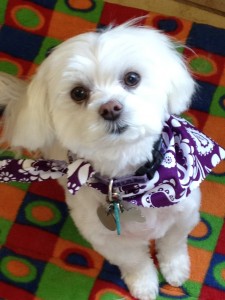
We ALWAYS get tail wags and sweet kisses from our four-legged friends when we meet in the lobby for their drop off– some pups even pull their owners straight to the spa door with their tails waving vigorously in the air! Whatever your pet may need, from medicated treatments for their coat and skin, to luxurious full spa treatments, we as your Snug spa team never cease to give them our absolute best care and love. We treat each one as if they are our own.
From the moment their furry paws enter our spa, they immediately pick up on the relaxed atmosphere and the aromatherapy scent of oils and lavender. Did you know that lavender is the most commonly used essential oil for helping to calm animals? It is soothing to the soul as well as to the skin for both humans and our pets! In the Snug Spa Salon we like to give our furry companions a few minutes in their own spa house to adjust and get comfortable before we begin. One of the steps we take to make sure that their stay is as relaxing and comfortable as possible, is to give them small breaks between spa services. Giving them breaks assures that they are never over-stimulated and helps to reduce stress. Our favorite step is giving them lots of love and special treats–as long as those treats are OK with Mom and Dad! Rewarding them and giving them positive reinforcement helps to boost their confidence and their trust in us! (more…)
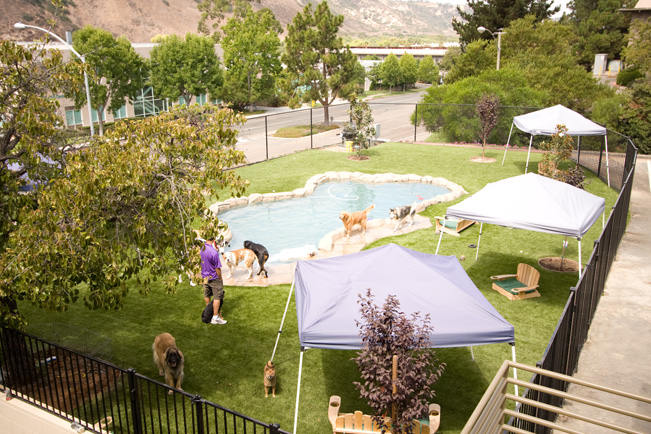 When deciding if your dog might be a good candidate for daycare, there are a few things to consider first. Some dogs are very social, love the interaction of daycare, and love playing all day with their best friends. Other dogs are more anti-social, don’t enjoy being away from their normal environment, and prefer not to be in daycare. Living in San Diego, most of us take our dogs to the dog beach or the dog park starting at a young age. When dogs are introduced to groups of dogs in this manner, starting young, they will be more willing to enjoy the benefits of daycare. Some dogs that are adopted or that change homes late in life and are not raised in a dog beach environment, tend to not enjoy a daycare atmosphere as much. Deciding on whether your dog is a good candidate for daycare has a lot to do with how they were raised and where they came from. Discussing your dog’s history with a professional trainer is a good way to know for sure if your dog really will enjoy daycare. (more…)
When deciding if your dog might be a good candidate for daycare, there are a few things to consider first. Some dogs are very social, love the interaction of daycare, and love playing all day with their best friends. Other dogs are more anti-social, don’t enjoy being away from their normal environment, and prefer not to be in daycare. Living in San Diego, most of us take our dogs to the dog beach or the dog park starting at a young age. When dogs are introduced to groups of dogs in this manner, starting young, they will be more willing to enjoy the benefits of daycare. Some dogs that are adopted or that change homes late in life and are not raised in a dog beach environment, tend to not enjoy a daycare atmosphere as much. Deciding on whether your dog is a good candidate for daycare has a lot to do with how they were raised and where they came from. Discussing your dog’s history with a professional trainer is a good way to know for sure if your dog really will enjoy daycare. (more…)
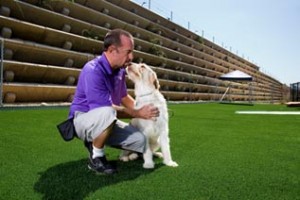
All dogs over time will regress in training and need some maintanence to keep their training sharp. Below are some reminders on how to keep your training up-to-date, and how you can incorporate it into your daily routine:
- Add three separate segments of training to all your daily walks. Mix in a few commands while out strolling and watch as your dog starts to improve again on walks.
- Try making dinner time an opportunity to add some obedience training into your routine! Prior to putting the food bowl down, have your dog perform a “down” or “sit/stay”. Start out with having your dog “stay” a few seconds, and then slowly increase the “stay” for up to 3 minutes. This can be a challenge at first, but with repetition this will get your dog sharp again on all “stay” commands.
- TV and doggie pushups! Next time you have a few minutes while watching TV, grab a few snacks and have your dog perform a “down” command. Give your dog a treat for success, and then have them perform a “sit” command from the “down” position. Give a treat for success and in no time at all, watch how fast your dog will start performing the doggie pushups!
- Incorporate playtime AND training time! While throwing the ball or playing with other toys, add obedience to the game. This gives your dog great exercise and allows for immediate reward using the toy for all commands.
- Saturday Class! Swing by Snug Pet Resort on Saturday mornings at 9:00 AM. Add one Saturday class to your calendar per month and come have fun for both you and your dog while keeping your dog’s training sharp. Class is free to all 3 week boot camp clients.
Remember, Snug Pet Resort is here every day to answer questions or give advice on any training issues!
Mike Stone
CEO
It’s that time of year….again!
FLEA AND HEARTWORM PREVENTATIVES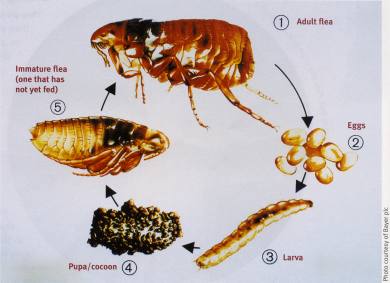
Fleas are a very common external parasite that can affect dogs and cats year-round in San Diego. Flea Allergic Dermatitis (FAD) is the most common veterinary dermatologic condition in the world! Signs include scratching, chewing, licking, and biting. Hair loss, reddened skin, and sores are common. Many dogs and cats that are allergic to the bite of a flea have very few fleas on them because their excessive grooming activity removes the flea.
Ingestion of fleas by your pet can lead to intestinal tapeworm (Dipylidium caninum) infestation.
Heartworm is now considered endemic to San Diego County. Heartworms are transmitted to dogs and cats through mosquito bites. The worms develop in the bloodstream and eventually lodge in the heart where they cause extensive damage. The good news is such a devastating disease is 100% preventable. (more…)
 By Groomer: Nina Zarceno
By Groomer: Nina Zarceno
We bring the luxury Hollywood A-list Spa services directly from L.A to your beloved pets’ second home: SNUG PET RESORT! Aromatherapy, deep massaging medicated baths, blueberry facials, soothing hypo-allergenic treatments and paw balm moisturizing ointments, there really is nothing we won’t spoil our clients with. Our professional team is highly trained to not only maintain and help restore your furry pal’s coat but to search for any dermatitis or skin issues. We have made it our goal to help catch any developing skin irritations and go straight to the source to solve the issue. Whether it is caused by seasonal allergies, food allergies, fleas or an uncommon irritation, our spa team is ready and willing to help. (more…)

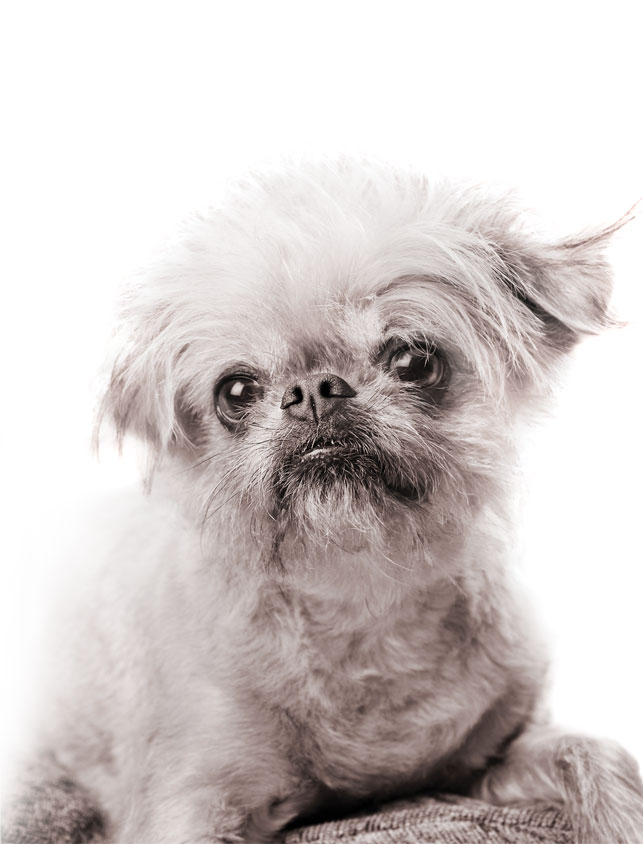



 When deciding if your dog might be a good candidate for daycare, there are a few things to consider first. Some dogs are very social, love the interaction of daycare, and love playing all day with their best friends. Other dogs are more anti-social, don’t enjoy being away from their normal environment, and prefer not to be in daycare. Living in San Diego, most of us take our dogs to the dog beach or the dog park starting at a young age. When dogs are introduced to groups of dogs in this manner, starting young, they will be more willing to enjoy the benefits of daycare. Some dogs that are adopted or that change homes late in life and are not raised in a dog beach environment, tend to not enjoy a daycare atmosphere as much. Deciding on whether your dog is a good candidate for daycare has a lot to do with how they were raised and where they came from. Discussing your dog’s history with a professional trainer is a good way to know for sure if your dog really will enjoy daycare.
When deciding if your dog might be a good candidate for daycare, there are a few things to consider first. Some dogs are very social, love the interaction of daycare, and love playing all day with their best friends. Other dogs are more anti-social, don’t enjoy being away from their normal environment, and prefer not to be in daycare. Living in San Diego, most of us take our dogs to the dog beach or the dog park starting at a young age. When dogs are introduced to groups of dogs in this manner, starting young, they will be more willing to enjoy the benefits of daycare. Some dogs that are adopted or that change homes late in life and are not raised in a dog beach environment, tend to not enjoy a daycare atmosphere as much. Deciding on whether your dog is a good candidate for daycare has a lot to do with how they were raised and where they came from. Discussing your dog’s history with a professional trainer is a good way to know for sure if your dog really will enjoy daycare. 

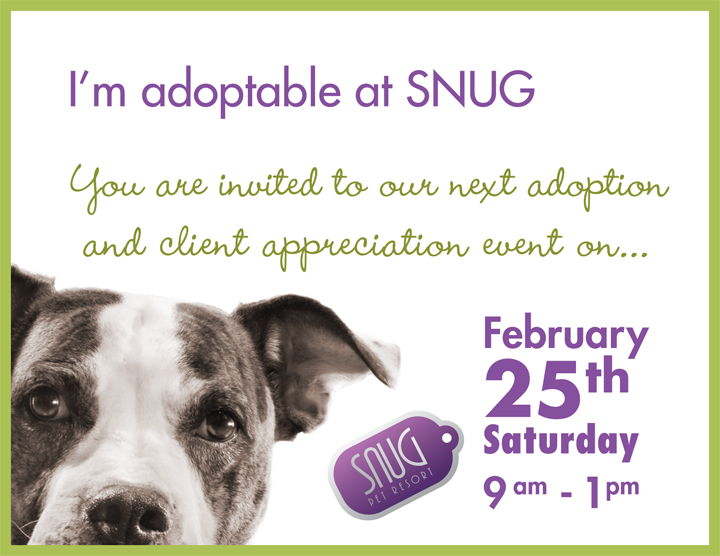

 By Groomer: Nina Zarceno
By Groomer: Nina Zarceno